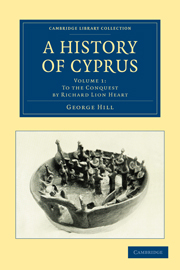Book contents
- Frontmatter
- Contents
- Preface
- List of Illustrations and Maps
- Lists of Books Consulted
- Chapter I The Land
- Chapter II The Stone Age
- Chapter III The Bronze Age
- Chapter IV The Religion of Early Cyprus
- Chapter V The Greek Colonization
- Chapter VI Phoenicians, Assyrians and Egyptians
- Chapter VII From Cyrus to Alexander
- Chapter VIII The Successors
- Chapter IX The Ptolemies
- Chapter X The Arts in Pre-Roman Cyprus
- Chapter XI The Roman Province
- Chapter XII Byzantium and Islam
- Addenda
- Index
- Plate section
Chapter IX - The Ptolemies
Published online by Cambridge University Press: 05 November 2011
- Frontmatter
- Contents
- Preface
- List of Illustrations and Maps
- Lists of Books Consulted
- Chapter I The Land
- Chapter II The Stone Age
- Chapter III The Bronze Age
- Chapter IV The Religion of Early Cyprus
- Chapter V The Greek Colonization
- Chapter VI Phoenicians, Assyrians and Egyptians
- Chapter VII From Cyrus to Alexander
- Chapter VIII The Successors
- Chapter IX The Ptolemies
- Chapter X The Arts in Pre-Roman Cyprus
- Chapter XI The Roman Province
- Chapter XII Byzantium and Islam
- Addenda
- Index
- Plate section
Summary
Cyprus under the Ptolemies continued to be exploited by the ruling power, and more efficiently than had been its lot hitherto. For with the suppression of the petty kingdoms, or their reduction to mere shadows, all their resources flowed into the treasury of Egypt except in so far as, when the island was under separate rule, they may have been wholly or partially absorbed by the Ptolemy who reigned as king in Cyprus. There is no need to enumerate again the manifold products which made the island so valuable a source of supply. Its corn was always—at least when it was not itself the victim of drought—available for less fortunate states; just as during the famine years 330–326 in Greece Athens was helped by private traders in Cyprus as well as Phoenicia, so Euergetes I was able to buy corn in Cyprus, as well as in Phoenicia and Syria and elsewhere, when Egypt was suffering from drought. The mines were still worked effectively, if the silver from which the vast Cyprus coinage of the period was struck came from the island; although the epigraphic evidence from the copper-mining districts (Soli and Tamassus) so active in earlier times, indicates by its scantiness that they were no longer flourishing. The shipbuilding industry was as important as ever; it was apparently in Cyprus that Philadelphus built two of his largest ships, a triakonteres and an eikoseres; his naval architect was Pyrgoteles son of Zoes, of whom the king thought so highly that he erected a statue to him at Paphos, of which the inscribed basis has survived.
- Type
- Chapter
- Information
- A History of Cyprus , pp. 173 - 211Publisher: Cambridge University PressPrint publication year: 2010First published in: 1940

